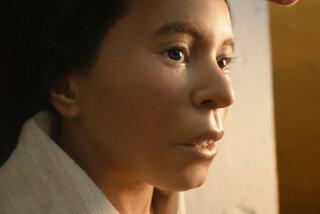DNA from skull links Ice Age girl to Native Americans alive today

- Share via
The divers called her Naia, for “water nymph,” because they discovered her teenage remains in a dark, underwater cave in Mexico’s Yucatan Peninsula.
She had been hidden there for more than 12,000 years — along with the bones of dozens of extinct Ice Age beasts — and divers quickly spotted her skull as they swept the chamber with flashlights.
“It was a small cranium laying upside-down with a perfect set of teeth and dark eye sockets looking back at us,” recalled diver Alberto Nava of Bay Area Underwater Explorers, a nonprofit conservation organization based in Berkeley.
On Thursday, researchers published a formal analysis of Naia’s skeletal remains in the journal Science, calling it the oldest, most complete specimen ever discovered in the Americas.
The study authors say the buck-toothed 15- or 16-year-old girl did not resemble today’s Native Americans — her cheeks were narrow and her forehead very high — but that her mitochondrial DNA reveals she is related to 11% of living American Indians, and links them genetically to a population of early humans who inhabited a land now submerged beneath the Bering Sea.
The researchers say the girl was probably very slight and stood just 4 feet, 10 inches tall. Her eyes were wide-set and low, and her nose was broad.
Carbon-dating of her teeth and isotope data from crystals that formed on her bones helped study authors determine that the girl lived 12,000 to 13,000 years ago in what would have been a very parched environment. They believe she was probably searching for water when she entered a dark, underground cave and then plummeted 100 feet into the massive chamber now called Hoyo Negro, or black hole.
Unable to escape — her hip bone shattered from the fall — she died amid a menagerie of similarly doomed megafauna, including saber-toothed cats, elephant-like gomphotheres and giant sloths. As the Ice Age ended and glaciers melted, sea levels rose and slowly filled the chamber with water, sealing it off from humanity.
Or at least it did until 2007, when scuba divers first explored the natural ossuary and discovered “a time capsule” of Central American life at the end of the Ice Age, according to study leader James Chatters, a paleoarchaeologist at Applied Paleoscience, a private research company in Bothell, Wash.
“It’s in many ways like a mini La Brea Tar Pits, but without the tar and considerably better preservation,” Chatters said of the Hoyo Negro site.
The study is among a number of recent genetic findings that have radically altered the long and heated debate over how humans first came to inhabit the New World.
Faced with stark differences of appearance between present-day Native Americans and ancient fossils, some archaeologists argued that the Americas were originally populated by people from Europe as well as Asia.
Within the last 10 years, however, DNA research has suggested that America’s founders emerged from a single ancestral population that initially came from Asia. Penned in perhaps by vast ice sheets, these people likely evolved in isolation for thousands of years in a land between Siberia and Alaska that scientists call Beringia. Then, as the glaciers retreated and Beringia began to disappear amid rising seas, the inhabitants spread swiftly through North and South America, scientists say.
Once situated in their new world, these founders, or Paleoamericans, would gradually evolve features that are now associated with Native Americans, according to the study authors. The physical differences that have puzzled researchers for so many years are not the result of separate origins, they argue.
“Paleoamericans and Native Americans descended from the same homeland,” Chatters said.
John Hoffecker, a paleoarchaeologist at the University of Colorado, Boulder, said the paper would help to reshape debate on the origins of the first Americans.
“For years archaeologists have been debating this trans-Atlantic thing and really it’s been an enormous distraction,” said Hoffecker, who did not participate in the Hoyo Negro study. “This helps us focus on Beringia, which is what we should have been doing all along.”
Michael Waters, an archaeologist at Texas A&M University who wasn’t involved in the study either, said he was excited to see what facial reconstructions of the girl’s skull would reveal.
“That will be pretty interesting,” Waters said. “These early skeletons are so rare we have to really get as much information as we can from them. Unfortunately, some of them have already been repatriated without any kind of DNA testing, so we’ll never know what secrets they held.”
Deborah Bolnick, a genetic anthropologist at the University of Texas at Austin and member of the study team, said researchers were attempting to extract nuclear DNA from the girl’s skeleton. That would provide genetic information from both parents, unlike mitochondrial DNA, which is only passed on by the mother.
Obtaining the nuclear DNA will be challenging, however. It is extremely fragmented, and it’s likely contaminated with bacteria, Bolnick said.
Currently, the girl’s remains are stored in a laboratory in Mexico’s National Institute of Anthropology and History, according to study co-author Pilar Luna Erreguerena, the head of the underwater archaeology at the institute in Mexico City.
Initially, researchers hoped to leave the bones in place, in keeping with conventions concerning the preservation of underwater cultural remains.
However, researchers removed her skull, jawbone, and other bones in March, after they discovered unauthorized divers were entering the chamber and damaging them, Erreguerena said.
“We were forced to recover five pieces of Naia so far,” she said.







